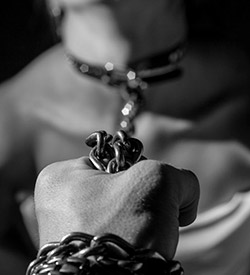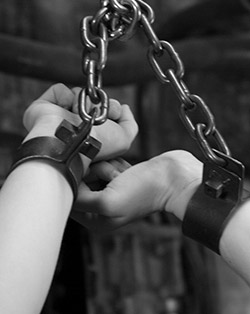by Hermes Solenzol
We need to rescue the word “sadist”. In the vanilla world it is often taken as a synonym of “cruel”, but in the BDSM culture we know this is not true. We are not cruel, we don’t like to cause suffering, just as masochists do not like to suffer. It is only that we sadomasochists like pain. Not any kind of pain, but a special type of pain. Pain that is felt in erogenous zones: the butt, the thighs, the feet, the back. Besides, the pain that we like also has a special quality: it warms and reddens the skin, awakening its sensibility. I like to call that kind of pain erotic pain.
However, in BDSM pain fulfils many other functions besides being a pleasant sensation in itself. In a D/s relationship pain is used as punishment. Many people have a “punishment fetish”: they like the idea of being punished or punishing somebody. The dynamic of punishment is one of the clearest forms of power exchange. We give power to another person to decide if what we do is right or wrong, and to make us pay for the consequences of our mistakes by inflicting pain on us or by making us do unpleasant tasks.
Another role of pain in BDSM is to induce altered states of consciousness, variously called sub-space, Top-space, adrenaline high or endorphin rush. BDSM sites and organizations are full of articles and talks on the purported neurochemical basis of these altered states of consciousness. Unfortunately, much of this is pseudoscience, a collection of myths that are not supported by any real scientific evidence. At best, they are just extrapolations to the BDSM scene of what we know about the neurophysiology of pain. Since there are practically no scientific studies done directly on sadomasochists, this is the only thing we can do at the moment. The bad news is that we simply do not have the scientific information to come up with an explanation for the altered states of consciousness that happen in the scene. The good news is that at least we can rule out some of the pseudoscientific myths that are being circulated. In this article I want to provide a summary of the most basic facts about pain transmission and processing, to provide a solid base of knowledge for our discussions.
The ability of the BDSM scene in general, and pain in particular, to produce altered states of consciousness is extremely important. It should not be taken with the frivolous attitude of someone taking a drug. Indeed, if what we want is a “high”, drugs can be a much simpler way to achieve it – although not one that I would recommend. The altered states of consciousness produced in the scene are valuable because they happen in a humane and emotional environment that can give them a profound meaning. The scene thus becomes a process of self-discovery and self-transformation.
But not all that happens in a BDSM scene is automatically good, there are many potential problems, drawbacks and dangers. For example, a lot of people are concerned about sub-drop, that state of unhappiness and depression that can take place in the hours or days following an intense scene. There are other concerns, though. Can certain practices undermine the autonomy or the self-esteem of the submissive? Can habituation to pain lead us to dangerous behavior? Can the pain high become addictive?
The health of the Top should also be taken into consideration. Could he become accustomed to inflicting pain? Will he objectify the submissive, turning her or him into a mere puppet to satisfy a compulsion?
These are objections that we find in the vanilla world, which we know from our own experience are not true. However, wouldn’t it be nice if we had some solid evidence to refute them? And there is always the possibility that some particular behavior may in fact be unhealthy for the Bottom or the Top.
PAIN PATHWAYS: FROM THE SKIN TO THE SPINAL CORD
The physical harm produced by canes, ridding crops, paddles or whips is taken up by the C-fibers and sent from the skin to the spinal cord as pain signals. C-fibers are the axons of a particular type of nerve cells, or neurons, whose bodies are located in the dorsal root ganglia nested between each pair of vertebrae at the sides of the spinal cord. There is another type of fiber, the A-fibers, which transmit normal touch sensation. The A-fibers are thicker than the C-fibers and, unlike them, are enveloped in a sheath of fatty tissue called myelin. The sensory nerves are bundles of millions of C- and A-fibers joined together by connective tissue.
Most C-fibers specialize in transmitting pain signals coming from the skin and, to a lesser extent, from muscles, joints, bones and inner organs. Because the skin forms the barrier between the body and the outside world, there are a lot of pain receptors posted there as sentinels against harm. For that reason, the skin tends to overreact sending out a lot of pain for relatively little harm.
With pain signals coming from the inside of the body (bones, joints and viscera) the issue is the opposite: a little pain can mean a serious problems. For us BDSMers, this means that “skin pain” is generally OK, but we should stay away from things that cause deep pain, like bondage that hurts the joints or impact play with heavy objects that can hurt muscles and bones.
 C-fibers do other things besides sending pain signals to the spinal cord. Signals can travel in them the other way: from the spinal cord to the skin. There they release substances that produce swelling and increase blood flow.
C-fibers do other things besides sending pain signals to the spinal cord. Signals can travel in them the other way: from the spinal cord to the skin. There they release substances that produce swelling and increase blood flow.
This inflammation is what causes the redness in the submissive’s butt after a good paddling, or those beautiful parallel lines of the cane marks. Inflammation of the skin is generally OK; it may even serve to stimulate and revitalize it with all that increased blood flow. Bruising, on the other hand, happens when capillaries are broken inside the skin. It heals, but it means a higher level of harm.
Pain signals traveling in the C-fibers reach the spinal cord at the part that is further to the back, called the dorsal horn. A-fibers in the same sensory nerves also send tactile signals to the dorsal horn. There pain gets altered in some curious ways. For example, when a pain signal combines with a tactile signal from the same area of the skin, the tactile signal decreases the pain. Therefore, a Top can erase the pain caused by a heavy stroke of a cane by caressing the bruise shortly afterwards. This is also the reason why we rub a part of the body that is aching.
What happens is that there are neurons in the dorsal horn able to increase or decrease the pain signal before sending it to the brain, and the sensations from both C-fibers and A-fibers converge in those neurons modifying each other. Apart from touch sensations carried by the A-fibers, pain can also be decreased by signals descending from the brain through particular nerve pathways, which I will describe later. The dorsal horn also processes other sensations coming from the skin, like itch, heat, warmth and cold, as well as sensations coming from the inside of the body.
PAIN PATHWAYS: FROM THE SPINAL CORD TO THE BRAIN
From the dorsal horn, pain signals cross two relay stations before reaching the brain cortex. One is the brain stem and the other the thalamus. At the brain stem, the pain signal interacts with the descending pain modulation pathways to decrease (or sometimes increase) future pain signals. The thalamus is a large area in the middle of the brain that acts as a central processor of all sensory sensations, not just pain and touch, but also hearing and seeing. From there, the pain sensation reaches its final destination, three regions of the brain cortex: the somatosensory cortex, the anterior cingulated cortex and the insula.
PAIN IN THE BRAIN
 Please, do not let all those unfamiliar names put you off. If you stay with me you’ll see how understanding the function of those brain areas is the key to understand the physiology of sadomasochism.
Please, do not let all those unfamiliar names put you off. If you stay with me you’ll see how understanding the function of those brain areas is the key to understand the physiology of sadomasochism.
The somatosensory cortex is a stripe that crosses the brain on its sides, from top to bottom, like a hairband. Its function is localize the part of the body where the pain is coming from… is it the butt, the thigh or the nipple? But it’s not there where pain hurts, where it becomes such a disagreeable (or pleasurable) sensation. That’s the job of the insula.
That name means “island” in Latin, because the insula is like an island of grey matter at the bottom of a deep fold of the cortex in the side of the brain. As I said, the insula is where we become aware of how much it hurts. It is also the origin of another interesting property of pain called “salience”. It means that pain has the ability of imposing itself on our conscious experience: if we are in pain, we don’t have the choice of not paying attention to it. That is why pain is so important to dominate somebody. If we give pain to a submissive, she cannot avoid giving us her undivided attention.
By the way, there is another sensation that has salience: pleasure. Indeed, the insula controls all the emotions associated with pain, positive or negative, as well as emotions associated with pleasure: sexual excitement and orgasm. The insula also plays a role in a variety of other emotions: sadness, joy, anger, disgust, indignation, empathy and even love.
Therefore, in that tiny area of the brain pain meets pleasure, and together they interact with all kind of emotions. In fact, scientists consider pain and pleasure more as emotions than as sensations. What this means in the context of BDSM is that pain occurs in intimate connection with all the other emotions that take place in the scene, influencing and being influenced by them. Moreover, pain and pleasure are not opposites, as usually thought. They can take place at the same time, and even reinforce each other.
The third brain area involved in pain is the anterior cingulated cortex (ACC). Anatomically, the cingulated cortex is the part of the cortex located in the surface where the two cerebral hemispheres touch each other. It forms a ring around the corpus callosum, which is the bundle of fibers that connect the two cerebral hemispheres.
The ACC is the frontal part of the cingulated cortex. It has similar functions to the insula but, while the insula is all about emotions, the ACC links emotions to knowledge. Its other functions are detecting errors, solving conflicts, and maintaining attention and motivation. It probably also mediates awareness, so we could say that the ACC is where we become conscious of feeling pain and get motivated to do something about it… even if it is just to endure it or enjoy it. It is here where pain can affect our conscious state.
In the second part of this article I will write about the nerve descending pathways that decrease pain and the “pleasure pathway” that releases dopamine and may contribute to the altered states of consciousness of the BDSM scene.
FURTHER READING
• Deviance & Desire – Ask a Neuroscientist: Altered States of Consciousness in BDSM
• Deviance & Desire – Endorphins and Adrenaline – What Science Really Says
• Deviance & Desire – Ask a Neuroscientist: Pain Physiology Explained to a Bottom
REFERENCES
1. Cervero F. Spinal cord hyperexcitability and its role in pain and hyperalgesia. Exp Brain Res 196: 129-37 (2009).
2. Craig AD. How do you feel? Interoception: the sense of the physiological condition of the body. Nat.Rev.Neurosci 3: 655-666 (2002).
3. Craig AD. Human feelings: why are some more aware than others? Trends Cogn Sci. 8: 239-241 (2004).
4. Craig AD. Interoception: the sense of the physiological condition of the body. Curr. Opin. Neurobiol. 13: 500-505 (2003).
5. Craig AD. A new view of pain as a homeostatic emotion. Trends Neurosci 26: 303-307 (2003).
6. Craig AD. Pain mechanisms: labeled lines versus convergence in central processing. Annu.Rev.Neurosci 26: 1-30 (2003).
7. Craig AD, Chen K, Bandy D, Reiman EM. Thermosensory activation of insular cortex. Nat.Neurosci 3: 184-190 (2000).
8. Craig AD, Zhang ET. Retrograde analyses of spinothalamic projections in the macaque monkey: input to posterolateral thalamus. J Comp Neurol 499: 953-64 (2006).
9. Hucho T, Levine JD. Signaling pathways in sensitization: toward a nociceptor cell biology. Neuron 55: 365-76 (2007).
10. Hunt SP, Mantyh PW. The molecular dynamics of pain control. Nat Rev Neurosci 2: 83-91 (2001).
11. Mogil JS. Animal models of pain: progress and challenges. Nat Rev Neurosci 10: 283-94 (2009).
12. Sandkuhler J. Models and mechanisms of hyperalgesia and allodynia. Physiol Rev 89: 707-58 (2009).
13. Tsunozaki M, Bautista DM. Mammalian somatosensory mechanotransduction. Curr Opin Neurobiol 19: 362-9 (2009).
14. Woolf CJ, Ma Q. Nociceptors–noxious stimulus detectors. Neuron 55: 353-64 (2007).
ABOUT THE AUTHOR
 Based in Los Angeles, California, Hermes Solenzol is a neuroscientist, and has been doing research on pain for several decades. In particular, he has been investigating endorphin release in rats. He has been a sadist for as long as he can remember and active in the scene for several decades.
Based in Los Angeles, California, Hermes Solenzol is a neuroscientist, and has been doing research on pain for several decades. In particular, he has been investigating endorphin release in rats. He has been a sadist for as long as he can remember and active in the scene for several decades.
Much of his writing is published in Spanish at Sexo, ciencia y espíritu, but there’s a great collection of articles on his English site, Sex, science and spirit. Along with a lot of BDSM wisdom, you’ll find thoughts on polyamory, communication, psychology and love.
He’s currently translating his first erotic novel from Spanish to English.


Excellent .
Remarkable! Thanks for this, it’s enlightening and provided me with insight as to why, physiologically and emotionally, I enjoy skin pain in a loving envoironment.
After reading an article like this, this terrifies me of even wanting to join BDSM and Kink and Fetishes.
Like, if pain has all these benefits and is healing, and therapeutic, and etc, then is it mandatory for BDSM? Is there any such thing as Pain-Free-BDSM?
Am I missing out on some deeper fulfillment by not liking pain and wanting nothing to do with it? Only getting one half of the equation by sticking with positivity, sunshine and rainbows and not daring to venture into the darkness? Something Spiritual that I can’t access without pain?
Essentially, I have High Functioning Autism/Asperger’s, and I am also HSP (Highly Sensitive Person) and any and all forms of physical pain in any way, shape or form is a HARD limit for me! I don’t like ANY pain AT ALL!!!